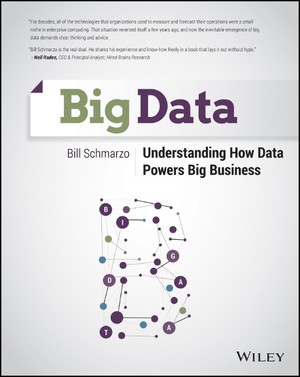Big Data: Understanding How Data Powers Big Business is yet another Big Data book to hit the market. What makes this book unique? There is practical advice and hands on exercises so that you end up with a Big Data action plan unique to your business after completion of the book. I spoke to the author, EMC’s own Big Data’s preeminent expert William Schmarzo, to explain the goals of his book and why organizations grappling with Big Data should pick it up.
1. What makes you a Big Data expert in providing practical advice for developing Big Data strategies?
EMC has allowed me to spend most of my time with a diverse customer base to learn what their current struggles are when it comes to Big Data. Based on their current data management, business intelligence and analytics environment and goals, we work together to come up with a strategy and plan for integrating Big Data into their key business processes. I have taken all of this experience and knowledge to come up with a set of best practices organizations can follow to start their Big Data projects and ensure success.
2. What was the catalyst for writing the book?
I was contacted by Wiley to write a book based on my EMC blog where I share information and best practices from my Big Data customer engagements. I thought it was a great idea but didn’t really move on it until my son gave me the idea of donating the book proceeds to charity. So the catalyst in writing the book was to not only give back to the community struggling with Big Data, but also to donate proceeds to Breast Cancer research in honor of my mother who died from Breast Cancer.
3. Your book is full of practical techniques, real-world examples, and hands-on exercises so all areas of the organization that can take full advantage of big data. What are the 3 most obvious areas of the organization that you feel businesses should immediately begin developing Big Data strategies for and why?
Each organization is very different so there isn’t a one size fits all approach, but rather what we do is we have customers analyze their most important business processes with respect to how big data could impact these business processes. For example, we are working with a transportation company where on-time delivery pick up is their most important business process. If they don’t pick up the delivery on time, the entire profitability for that route is gone. So their goal was to leverage Big Data to improve ‘on time delivery pickup’ by a defined percentage. We are also working with a wind turbine energy company where predictive maintenance is the most important business process. Using Big Data, if they can predict when a part is about to wear out or break, they can have it replaced before any more serious damage and downtime is caused.
4. Give me an example of a hands-on exercise or worksheet from the book that you feel will really help businesses start defining a Big Data strategy.
There are three different exercises based on value chain analysis that force organizations to apply the four Big Data business drivers against their key business processes. These four Big Data business drivers are 1) access to all of the detailed transactional data, not just the summary data that is typically available within their data warehouse, 2) access to unstructured data both inside and outside of the organization, 3) ability to apply real time analytics to shrink the time latency from when an key event occurs to the ability to access, analyze and act on the event, and 4) integrate predictive analytics into the key business process. This exercise really allows organizations to think about what Big Data can do improve their overall value chain processes.
5. What are the 3 major takeaways from the book?
First, you can get a Big Data project started by focusing on a key business process that is already supported by your existing business intelligence and data warehouse environment. Leverage Big Data to take that business process to the next level.
Second, as organizations dig deep into Big Data they will find a diverse set of insights around customers, products, operations, and more. By applying these insights, for example, organization can re-wire their interactions with customers to build a more engaging, more sticky, more profitable relationship.
Third, Big Data has a liberating organizational effect whereby once users start to experiment with data and see positive results, more people in the organization will get involved to share ideas and collaborate around Big Data. No longer do you have a single department head making decisions around data, but rather people working together to come up with new ideas as to how to solve key business problems.
